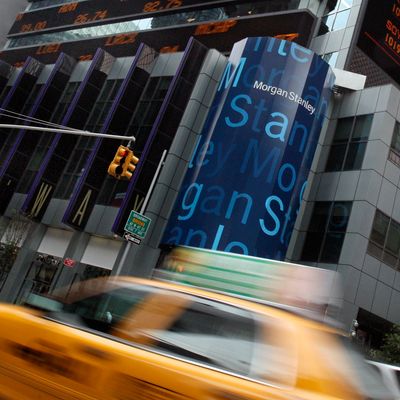
If you’re even a casual observer of the business world or the financial sector, you’ll hear a lot about the prospects of big Wall Street banks next week. That’s when most banks report their year-end earnings, and afterwards, investors and pundits will use lots of complicated-sounding metrics — return on equity, price-to-book ratio, comp ratio, and the like — to sort out the ones that are being well-managed from the shoddy ones investors should avoid.
But reader, you can skip all of this and assess banks in a much easier way. To tell which banks are doing good things and which are being run by self-deluding crazy people, all you have to do is listen for two simple words: secular and cyclical.
Bankers argue about these two words a lot, especially when they’re losing money. The debate, in general terms, is about whether a given company’s performance is explained by the long-term trends of its industry (secular), or whether it simply fluctuates naturally as a function of time (cyclical). For instance, the turkey industry experiences cyclical setbacks every December, after Thanksgiving is over, whereas the newspaper industry is in secular decline, steadily decimated by challenges to its basic business model. Newspaper advertising revenues just aren’t coming back — turkey companies, on the other hand, have to wait for next November.
The problems facing Wall Street are almost certainly more like the ones facing the newspaper industry than the ones facing the Thanksgiving turkey market. The Dodd-Frank regulatory regime, which prohibits risky (and profitable) things like proprietary trading, and the Basel III standards, which require banks to hold more capital against possible losses, have effectively lowered the speed limit for banks. Now, instead of going 100 miles per hour, banks are only allowed to top out at 70 — it’s still a fast ride, but nowhere near the old speed. And while banks can (and should) redesign themselves to operate more efficiently at 70 mph, it would be silly to spend all their time pining for the 100 mph glory days.
“The operating environment is unlikely to change any time soon, and we see shareholders of challenged banks becoming more demanding in asking management teams to lay out a path to unlocking value in the near term,” a team of Goldman Sachs analysts wrote last year.
But — and here’s the skeleton key for next week’s earnings — some big-bank CEOs don’t understand that things have fundamentally changed, or aren’t willing to admit it publicly. They insist that happy days are almost here again, and despite the new regulations that limit risk and shave down their profit margins, Wall Street will get its mojo back once the broader economy recovers fully.
Lloyd Blankfein, for example, thinks Wall Street’s setbacks are just temporary. In November 2011, he disagreed with his own analysts, saying, “I don’t think we can conclude that the slowdown is secular rather than cyclical change.”
At JPMorgan Chase, Jamie Dimon has also dismissed questions about secular change. Last year, he shrugged off a tough quarter for his investment bank by saying, “Is the downturn you saw in the fourth quarter cyclical or secular? We’re telling you it is cyclical. I’m not hedging that, OK. It is cyclical.”
The financial sector will recover some of its losses when the economy picks up — that’s the cyclical part. But they won’t get back to their pre-crisis profit levels, no matter what gimmicks and rearrangements they try. It’s just impossible. As Gabriel Sherman put it last year, “the strictures that are holding the banks back now are tighter than any since the thirties.” And in dismissing the long-term secular changes in explaining what’s wrong, CEOs who talk about cyclicality only are giving sunny pep talks, not realistic diagnoses of what ails them.
Some bank executives get it. Brian Moynihan, the CEO of Bank of America, took painful cost-cutting and capital-raising steps that hurt in the short term, but have helped put his firm back on solid ground. Recently deposed Citigroup CEO Vikram Pandit, when asked about the secular versus cyclical debate last year, said that “some of what you are seeing” is cyclical, but that “the secular things are big enough” to worry about. “All the big banks are going to have to deal with them in a very methodical way,” he added.
Morgan Stanley seems to get it, too. Since the crisis, the bank has fundamentally reshaped itself, cutting back on unprofitable divisions like fixed-income trading and boosting its boring-but-profitable wealth management business. Executives there may not like the fact that “the Morgan Stanley we knew [is] never coming back,” as one told DealBook this week. But at least they’re not in denial.
Picking “cyclical” over “secular” as a bank CEO is not just an academic exercise. It has real-life implications for how you run your bank. CEOs that expect cyclical changes tend to do things like keep unprofitable trading divisions around, expecting that they’ll someday become profitable. They also tend to shy away from hard, painful changes like layoffs. (After all, if things are going to get better in a year, why fire people you’re eventually going to rehire?)
And for that reason, if I were an investor (which I’m not), I would run screaming from any bank whose executives used the word “cyclical” next week to shrug off problems and losses, rather than acknowledging that secular changes in the banking sector mean that the boom days of 2006 are never, ever coming back. Refusing to deal with large-scale challenges until it was too late was the flaw that brought down Lehman Brothers and Bear Stearns. In banking, as with most things, you can’t fix a problem if you’re not willing to admit it’s there.





























